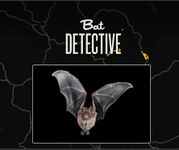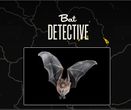Bat detective
Cs Portal > List of citizen science projects > Bat detective - (2013/12/09)
IDENTIFICATION
- Beta start date : N/A
- End date : Still open.
- Natural sciences > zoology (nature/conservation)
- Others in the same subject areas: Air Quality with Biomarkers, Andromeda Project, Budburst, Celebrate Urban Birds... further results
- Others projects about nature/conservation: Air Quality with Biomarkers, Celebrate Urban Birds, Evolution MegaLab, ExCiteS forest monitoring... further results
⇳ Description Bat Detective is an Zooniverse citizen science project which asks the public to turn detective to find bat calls in audio recordings across the world ➠ Purpose Mapping out bat ‘hotspots’ by using recordings and classifying the sounds they make for echolocation and social purposes. ? Research question Calls that bats use for socialising are not used for echolocation but communication, and these calls tend to be lower in frequency and have a more complex structure. Only under a third of all the echolocation calls of bats worldwide are known and even less is understood about social calls. Perhaps only 5% of all species social calls have been recorded.
TEAM
University College London
Project team page http://www.batdetective.org/#!/about/team/science Leader: Kate Jones Institution: University College London Partner institutions: Zoological Society of London, The Bat Conservation Trust, BatLife Europe, University of Auckland, the Citizen Science Alliance. Contact: Bat detect team on twitter https://twitter.com/batdetect
USER TASKS
CONTRIBUTION TYPE: data interpretation
PARTICIPATION TYPOLOGY: crowdsourcing
GAMING GENRE NONE
GAMING ELEMENTS: NONE
◉ Tasks description Participants are required to differentiate between a bat and a non-bat call, the different types of calls and what sequence a call belongs in. ⤯ Interaction with objects The user will categorise bat calls by listening to, and looking at visualisations of, bat call recordings. ▣ Interface
- Data type to manipulate: sound
- interface enjoyment: cool/attractive
- Interface usability: rather easy to use
GUIDANCE
- Tutorial: ✓
- Peer to peer guidance: Somewhat
- Training sequence: Somewhat
- Individual performance: Somewhat
- Collective performance: Somewhat
- Research progress: Somewhat
❂ Feedback and guidance description
COMMUNITY
- Main news site: http://blog.batdetective.org/
- Frequency of project news updates: less than weekly
- Type of events: other
- Frequency of events : 5
⏣ Community description
- Community size (volounteers based) 671
- Role:
- Interaction form: Twitter and http://talk.batdetective.org/
- Has official community manager(s): N/A
- Has team work N/A
- Other: Blog contains most of the news/community updates. There was a google hangout with the bat detective team on 20/12/2013. Although there is some community participation in the comments, the blog is rather quiet(the last post was made on 7/2/2013). The twitter feed (@batdetect) is more active, as is the facebook page (https://www.facebook.com/batdetective).
- Community led additions:
Other information
PROJECT
Url:http://www.batdetective.org/
Start date: 2012/10/04
End date: Still open
Infrastructure: Zooniverse
TEAM
Official team page:http://www.batdetective.org/#!/about/team/science
Leader: Kate Jones
Institution: University College London
Partner institutions: Zoological Society of London, The Bat Conservation Trust, BatLife Europe, University of Auckland, the Citizen Science Alliance.
Contact: https://twitter.com/batdetect
Main location: University College London
PROJECT DEFINITION
Subject
Natural sciences > zoology (nature/conservation)
Description
Bat Detective is an Zooniverse citizen science project which asks the public to turn detective to find bat calls in audio recordings across the world
Purpose.
Mapping out bat ‘hotspots’ by using recordings and classifying the sounds they make for echolocation and social purposes.
Research question.
Calls that bats use for socialising are not used for echolocation but communication, and these calls tend to be lower in frequency and have a more complex structure. Only under a third of all the echolocation calls of bats worldwide are known and even less is understood about social calls. Perhaps only 5% of all species social calls have been recorded.
ABOUT PARTICIPANT TASKS
Tasks description.
Participants are required to differentiate between a bat and a non-bat call, the different types of calls and what sequence a call belongs in.
Interaction with system objects.
The user will categorise bat calls by listening to, and looking at visualisations of, bat call recordings.
| Grey typology | Participation typology | Contribution type: | ||||||||||||||||||||||||||||
|---|---|---|---|---|---|---|---|---|---|---|---|---|---|---|---|---|---|---|---|---|---|---|---|---|---|---|---|---|---|---|
|
|
|
||||||||||||||||||||||||||||
| Gaming | ||||||||||||||||||||||||||||||
| Genre: | Gaming elements: | |||||||||||||||||||||||||||||
| Interface | ||||||||||||||||||||||||||||||
| Data type to manipulate: sound | interface enjoyment: cool/attractive Interface usability: rather easy to use |
Member profiles::N/A Member profile elements: |
||||||||||||||||||||||||||||
ABOUT GUIDANCE AND FEEDBACK
| Guidance | Feedback on | ||||||||||||
|---|---|---|---|---|---|---|---|---|---|---|---|---|---|
|
|
.
COMMUNITY
| Tools | News & Events |
|---|---|
|
Communication: website, blog, other |
Main news site: http://blog.batdetective.org/ |
| Community description | |
|
Community size (volounteers based): 671 |
|
Other information about community: Blog contains most of the news/community updates. There was a google hangout with the bat detective team on 20/12/2013. Although there is some community participation in the comments, the blog is rather quiet(the last post was made on 7/2/2013). The twitter feed (@batdetect) is more active, as is the facebook page (https://www.facebook.com/batdetective).
Community led additions:
OTHER PROJECT INFORMATION
batdetective.jpg Yes [[has completion level::High]
http://www.batdetective.org/#!/about/team/science Bat detect team on twitter University College London https://twitter.com/batdetect
Yes zoology Natural sciences nature/conservation Mapping out bat ‘hotspots’ by using recordings and classifying the sounds they make for echolocation and social purposes. Calls that bats use for socialising are not used for echolocation but communication, and these calls tend to be lower in frequency and have a more complex structure. Only under a third of all the echolocation calls of bats worldwide are known and even less is understood about social calls. Perhaps only 5% of all species social calls have been recorded.
Bat detective Participants are required to differentiate between a bat and a non-bat call, the different types of calls and what sequence a call belongs in. data interpretation
crowdsourcing sound, other: Thinking: yes Computing: no Sensing: no Gaming: no
The user will categorise bat calls by listening to, and looking at visualisations of, bat call recordings.
cool/attractive
rather easy to use
yes
N/A
weak
N/A
N/A
N/A
N/A
N/A website, blog, other Twitter, Facebook, other other 5 http://blog.batdetective.org/ 671 less than weekly Blog contains most of the news/community updates. There was a google hangout with the bat detective team on 20/12/2013. Although there is some community participation in the comments, the blog is rather quiet(the last post was made on 7/2/2013). The twitter feed (@batdetect) is more active, as is the facebook page (https://www.facebook.com/batdetective).
Twitter and http://talk.batdetective.org/ N/A Various science blogs and an appearance on BBC news
High
Bibliography
| BIBLIOGRAPHY |
The signup/login process is not working as of 9/12/2013 on firefox, chrome or safari. The project does not look particularly active at the moment.
. Bat detective team
. Bat detective team
Bat Detective. Unknown
- ➥ http://www.scientificamerican.com/citizen-science/project.cfm?id=zooniverse-bat-detective
- 💬 Part of the Citizen Science section of the Scientific American Website
Bat Detective. Unknown
- http://www.scientificamerican.com/citizen-science/project.cfm?id=zooniverse-bat-detective
- Part of the Citizen Science section of the Scientific American Website
Website calls on people to become 'bat detectives'. Mark Kinver
Website calls on people to become 'bat detectives'. Mark Kinver
Become a Bat Detective. Lily Bui
Become a Bat Detective. Lily Bui



